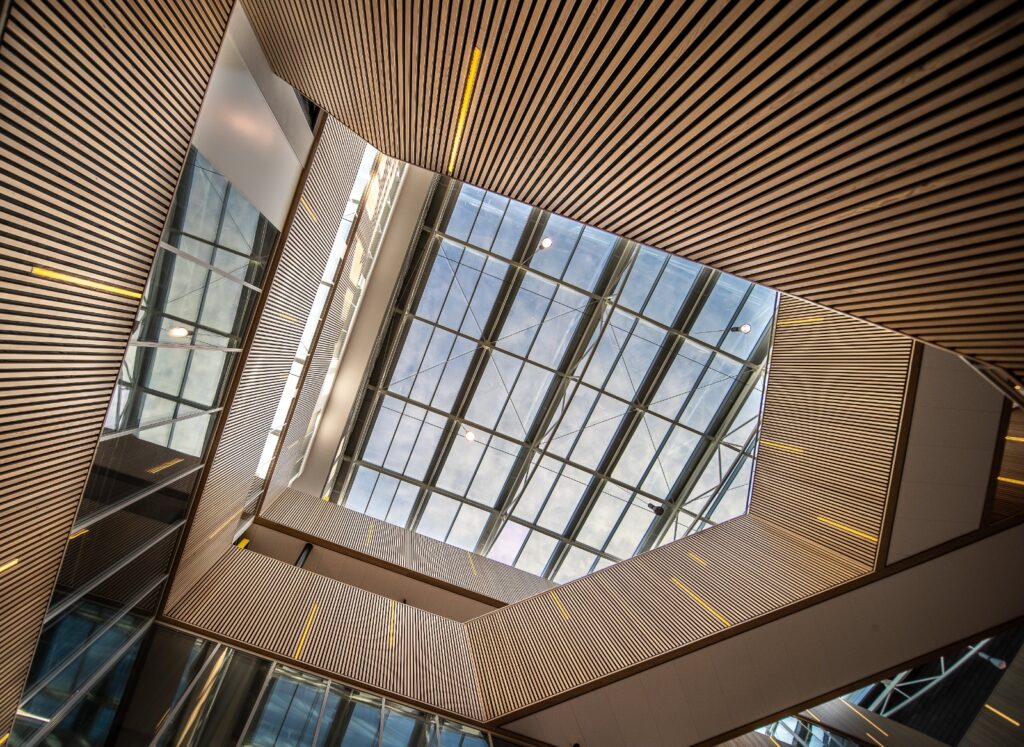In the world of design and architecture, every detail counts. From the furniture arrangement to the choice of wall colours, every element has an impact on the user experience in a given space. One of the lesser known but equally crucial aspects of architecture is acoustics. The way we interact with sound in a space can influence our perception and comfort. In this blog we will explore acoustic architecture and how surfaces can be harnessed to optimise the sound experience in different environments.

Illustration 1: Songdo central park. Photo by freepik
What is acoustic architecture?
Acoustic architecture is a branch of architecture that focuses on the manipulation of sound in the built environment. Its main objective is to create spaces where sound behaves as desired, whether for better sound quality in a concert hall, clarity in a conference room or noise reduction in a bustling restaurant. The aim is to enhance the acoustic experience and functionality of each environment.
Architectural acoustics is based on understanding how sound interacts with the surfaces and materials present in a space. From sound reflection and absorption to diffusion and transmission, every aspect of acoustics must be considered when designing an environment to ensure an optimal sound experience. In addition, factors such as architectural shapes and ceiling height influence the way sound behaves in a space, affecting the quality of the acoustics. By delving deeper into these aspects, we can design aesthetically appealing spaces that provide an exceptional sound experience, while remaining at the forefront of innovation in a constantly evolving world.
The Importance of Acoustics in Design and Architecture
Acoustics influence the way we perceive and enjoy sound in any space. Poor acoustics can distort music, hinder communication in a meeting or create discomfort in a noisy space. On the other hand, well-designed acoustics can enhance the user experience and create a pleasant and functional environment.

Illustration 2: Stone amphitheatre. Photo freepik.
In entertainment venues such as theatres and concert halls, acoustics are crucial. Careful selection of materials and surfaces is essential to allow for even sound distribution and controlled reverberation. Today, advanced materials such as acoustic panels, diffusers and absorbing materials are used to achieve this. These technological advances have revolutionised the quality of sound in these venues, providing each spectator with an exceptional listening experience. The constant advances in the field of architectural acoustics has led to innovative solutions that continue to improve the sound quality in theatres and concert halls.
Acoustics also play an important role for customers’ comfort in leisure spaces such as restaurants, bars and cafés. Sound absorption and diffusion can help reduce potential noise and create a more pleasant environment.
How surfaces influence the sound experience
In a given space, the selection and appropriate treatment of surfaces and materials play an essential role in the quality and perception of sound.
An example of this is sound absorption, which is essential to reduce reverberation in a space. Materials such as acoustic panels, suspended ceilings and carpets can absorb sound and prevent it from bouncing off the walls, creating a quieter and more comfortable environment.
Meanwhile, sound diffusion involves scattering sound waves in multiple directions rather than reflecting them directly. Textured surfaces, such as patterned walls or diffusion panels, can improve sound clarity and prevent sound from building up in specific areas.
In some cases, sound reflection can be beneficial, such as in a concert hall. Reflective surfaces, such as wooden walls, can help direct sound towards the audience and create an immersive experience.
It’s important to remember that sound insulation is crucial in environments where the aim is to prevent sound from spreading from one room to another. Doors, windows and walls soundproofed with thick, dense materials can effectively block unwanted sound.

Illustration 3: Design ceiling. Photo by Mike van Schoonderwalt on freepik
Strategies for optimising acoustic architecture
There are different strategies that design and architecture professionals employ to optimise the acoustic architecture of their projects, such as:
Acoustic diffusion pattern designs. Designers can implement specific patterns on the surfaces of the space to control how sound is dispersed and avoid unwanted reflections.
Choosing absorbent materials. The choice of absorbent materials, such as sound absorbing panels, heavy curtains and suspended ceilings, is essential to reduce reverberation and improve sound quality.
Sound reflection control. The design should take into account surface orientation and the arrangement of elements to avoid disruptive reflections.
Acoustic modelling and simulation. Prior to construction, acoustic modelling analyses can be performed to predict and adjust the acoustics of the space virtually.
Sound system integration. Designers must strategically plan where to place loudspeakers and microphones to ensure even sound distribution.
On-site testing and adjustment. Sound testing of the finished space is essential to ensure that the acoustic objectives have been met. Adjustments may include optimisation of sound absorption and diffusion.
Continuous learning. Given the constant developments in the field of acoustic architecture, professionals must keep up to date with the latest research and technologies to offer optimal solutions to their clients.
Success stories
To better understand the importance of acoustic architecture and how surfaces can influence the sound experience, we will look at some examples:
Teatro alla Scala, Milan
The Teatro alla Scala theatre in Milan is widely acclaimed for its exceptional acoustics, a feature that makes it one of the world’s leading musical venues. This was achieved thanks to a meticulous combination of architectural design and material selection that transforms the listening experience for the audience.
The design of the concert hall is one of the pillars of its success. Every architectural detail, from the layout of the surfaces to the shape of the hall, has been designed to achieve an even sound distribution. This results in exceptionally clear and rich acoustics, without the interference of unwanted reflections.
The cladding materials used on the walls and ceiling play a key role. They were carefully selected for their acoustic properties, including sound absorption and diffusion control. This combination of materials creates a reverberation that enhances the quality of the music played on stage, providing a unique sound experience.
The theatre has also incorporated advanced acoustic insulation techniques to protect the integrity of the sound inside. The result is an immersive environment where music is heard with impressive clarity, without the distractions of outside noise.

Illustration 4: Teatro alla Scala in Milan. Photo Shutterstock
Sydney Opera House
The Sydney Opera House is an iconic example of architectural design that features exceptional acoustic details. The curved and textured surfaces of the concert halls help to spread the sound evenly, providing an outstanding listening experience for the audience.

Illustration 5: Opera House, Sydney, Australia. Photo unsplash
Open plan offices
In the world of open-plan workspaces, the use of suspended acoustic panels and absorbent materials in work areas can significantly reduce background noise, improving employee concentration and productivity.

Ilustración 6: Copernico Blend Tower, Piazza Quattro Novembre, Milan. Photo Unsplash.
Acoustic architecture is an essential field of contemporary design and architecture. The way we interact with sound in a space can have a significant impact on our perception and comfort. By understanding how surfaces and materials can influence the acoustics of an environment, professionals can create spaces that are not only visually appealing, but also aurally exceptional. Paying attention to acoustic details can mark the difference in the quality and success of a built space.

